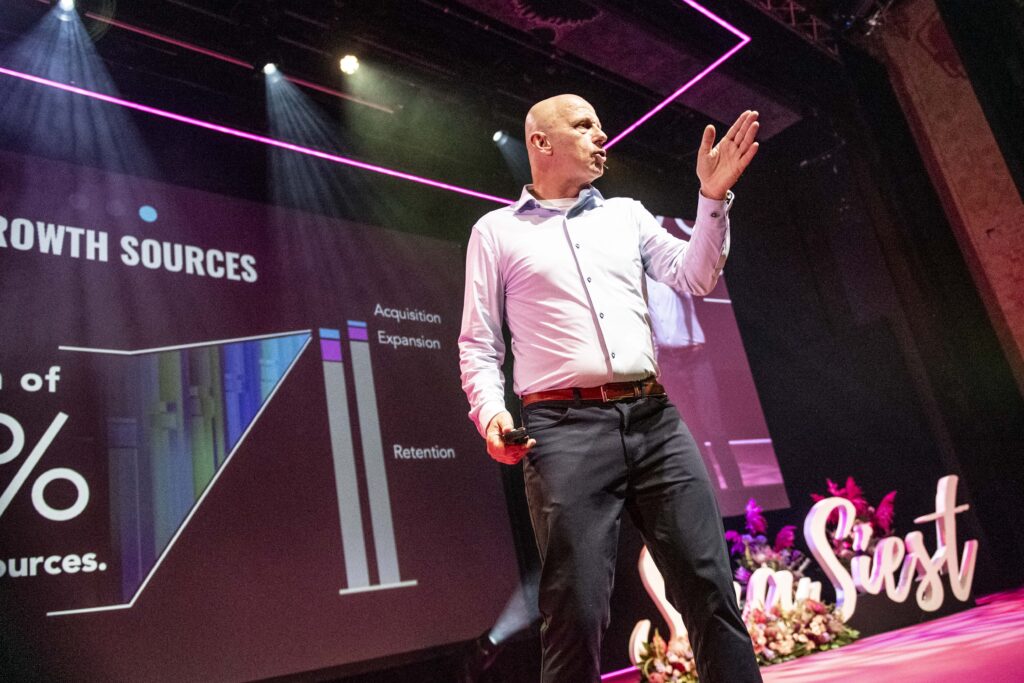We’re still obsessed with logos. And it’s holding us back.
In today’s SaaS landscape, most go-to-market teams are still wired for acquisition. Sales and marketing spend the vast majority of their budget chasing net new logos, while existing users sit on the sidelines, under leveraged.
Jacco van der Kooij, Founder of Winning by Design, argues that this approach is broken. Speaking at SaaSiest 2025, he made a compelling case for shifting from a customer acquisition mindset to a user activation motion.
The goal? Tap into the human engine of SaaS growth – users who love your product and talk about it.
From logos to users: why this mindset shift matters now
The economic reality for SaaS hasn’t improved much since 2023. Growth is slower. Costs are higher. AI-native startups are scaling faster, not just because of better technology, but because they’re playing a different game.
Jacco shared a simple but powerful observation:
“If customers fuel our growth, how is it that growth slows down when we finally have thousands of customers?”
The answer: most SaaS companies are built to acquire, not to grow through their users.
Instead of doubling down on what’s working — happy users and real usage — companies continue to pour 95 percent of their GTM resources into cold outreach, MQL generation, and paid acquisition.

Introducing the user-led growth model
Jacco mapped a clear new motion that sits outside the traditional bow tie framework.
Think of three key revenue sources:
- Acquisition — winning new customers
- Retention — keeping existing customers
- Expansion — growing accounts over time
But there’s a fourth growth lever hiding in plain sight: users who advocate for your product.
These are not “logos.” They’re individuals already using your tool, already part of your ICP, who are best positioned to drive word-of-mouth and warm pipeline.
And unlike traditional marketing funnels, this motion:
- Has built-in trust
- Costs significantly less
- Scales with your customer base
Jacco put it plainly:
“If even 1 out of 100 users talked about your product once a year, you’d unlock a new pipeline channel without spending another euro on paid.”
The math behind user-led growth
Here’s how this plays out with real numbers.
Let’s say you have 500 customers, each with 10 users. That gives you 5,000 potential advocates.
If just 1 percent of them recommend your product when asked — for example, in a peer conversation — that’s 50 warm, high-quality opportunities per year. At 2 percent, that’s 100.
These aren’t random MQLs. They’re referral-grade leads with built-in intent, cutting out the cold top of funnel entirely.
“The opportunities they create are not MQLs,” Jacco explained. “They’re hardcore SQLs.”
This isn’t hypothetical. Native AI companies like Cursor, Notion, and OpenAI already grow this way, organically and by design. Users evangelize the product. New accounts pop up. Growth compounds.
Why most SaaS companies are missing this
Most teams are stuck in a cycle of high-volume acquisition. One SaaS company Jacco worked with — on its way from $200M to $1B ARR — was generating 5,000 to 8,000 new leads per month just to stay on target.
“Every month starts at zero. It’s insane. You can’t keep this up.”
The problem isn’t just strategy. It’s mindset.
We see customers as logos to win and keep. We don’t see them as networks of users who can help us grow.
And we fail to build GTM motions that activate those users. Instead, we shoot polished case study videos or gather NPS scores. But that’s not advocacy. It’s just marketing content.
A playbook for activating users as a pipeline engine
To harness user-led growth, Jacco laid out three concrete shifts.
1. Tier your user base
Not all users are equal. Build cohorts based on behavior and influence:
- Super users — heavy users with high usage frequency
- Ambassadors — users willing to promote or refer
- Lurkers — low-engagement users who need nurturing
Tailor your engagement accordingly. Don’t burn out your best users — enable them to lead.
2. Run cohort-based campaigns
Instead of generic newsletters or product updates, build targeted plays:
- Peer roundtables for super users
- Referral programs for ambassadors
- Education tracks for lurkers
These are not traditional demand generation campaigns. They are designed to build trust, community, and sharing.
3. Create human-led moments
AI may be taking over inboxes, but real humans still crave connection.
Jacco emphasized the value of:
- In-person user groups
- Local meetups and expert sessions
- Informal communities led by users
“In a world where AI takes over, human connection becomes your differentiator.”
What changes if you get this right?
By focusing on users, not just customers, companies unlock a motion that:
- Becomes more efficient as you scale
- Builds a renewable source of warm pipeline
- Enhances retention and expansion at the same time
- Reduces the GTM pressure to constantly chase new logos
It also builds defensibility. Products that spread through usage, not ads, are harder to copy — and easier to love.
Final takeaway
The biggest barrier to user-led growth isn’t tooling or tactics. It’s the mindset shift from logo-chasing to user activation.
“We’re not here to retain customers,” Jacco said. “We’re here to activate users who help us grow.”
If you want to scale like an AI-native business, reduce CAC, and create true network effects, your users are the best growth engine you already have.
Start there.
Watch Jacco’s full session at SaaSiest 2025 here